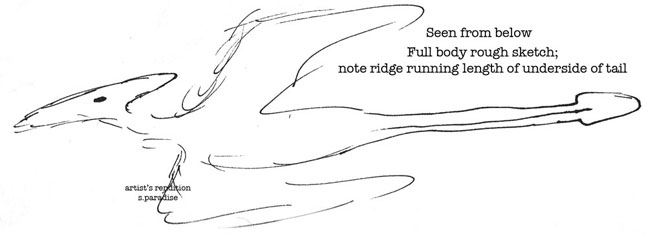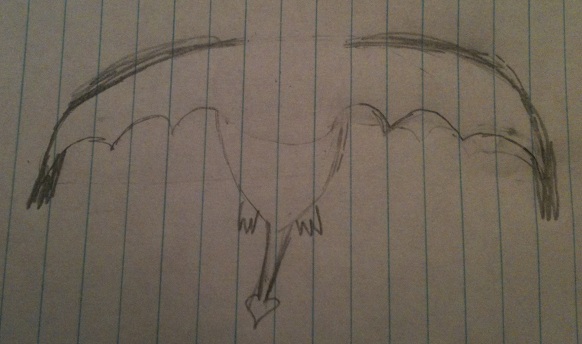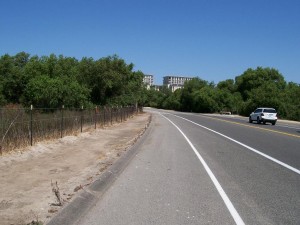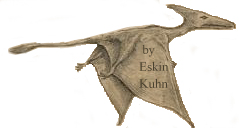Rhamphorhynchoid Tail Structure
Modern pterosaur eyewitnesses often report a structure at the end of the long tail of the flying creature, with different witnesses using different words for the structure:
- diamond (many sightings, including Michigan, 2007)
- lemon shape (Indiana, about 2006)
- sail (Texas, about 1982)
- spade (Kentucky, 2008 and North Carolina in 2013)
- spike (New Mexico, 1993)
- triangle-shaped (California, 2007 and 2012)
Among scientists, the word “vane” is used for that structure (on pterosaur fossils) at the end of many of the long tails, although some use the word “flange.” Among non-scientists, the word “Rhamphorhynchoid” is little-known, but it refers to what paleontologists call the “basal” pterosaurs.
Orientation of Tail Vane
In the book The Illustrated Encyclopedia of Pterosaurs, by Peter Wellnhofer, the work of Othniel Charles Marsh (nineteenth century) is mentioned regarding tail vane orientation:
“A particular controversy developed around [terminal tail vane orientation] . . . vertically or horizontally? Was it to be interpreted as intended to control height or sideways movement? [In airplane principle-axes terminology, a flap parallel to the ground surface controls pitch; a flap oriented like ship rudders controls yaw.] Marsh oriented it . . . vertically as he had noticed a slight asymmetry in the outline. Later for aerodynamic reasons it was seen as a height control and oriented horizontally. But several indications suggest that Marsh was right after all.”
Eyewitnesses, however, seem to show that Marsh was wrong. The tail vanes of modern pterosaurs, according to three eyewitnesses, are oriented horizontally, allowing the long-tailed flying creatures to change direction up and down. Plane pilots call this “pitch control.”
Three eyewitness make it clear how the tail flange is oriented for modern Rhamphorhynchoid pterosaurs.
- Sandra Paradise — I spoke with Sandy by phone two days ago, bringing up the tail-vane orientation with no warning. Without hesitation she informed me, making it clear that she had seen the tail-end structure oriented horizontally, parallel to the surface of the road on which she was driving.
- Patty Carson — She was sure about the orientation of the long tail on the “dinosaur” that flew away from her and her brother, in 1965 at Guantanamo Bay, Cuba. She let me know that there was no doubt: horizontal. I continued questioning her to be sure there was no misunderstanding, she confirmed it.
- Anonymous Eyewitness — The lady who saw the “pterodactyl” in her backyard, on June 19, 2012, in Lakewood, only a few miles from my house in Long Beach, California, answered my many questions. When we got to the subject of tail vane orientation, she had no doubt that it was horizontal. And her nose was less than twenty feet from that particular tail vane.

Sketch drawn by the eyewitness Sandra Paradise, who was sure of horizontal tail-flange orientation—she also gave many details about the tail
.

Crude sketch drawn by an eyewitness of a modern pterosaur seen in Virginia
.
Statistics on Pterosaur Tails
The latest analysis from the data collected from 128 sighting reports (chosen because they appeared more likely than not to have been from actual encounters with modern pterosaurs) reveals the following about pterosaur tails:
For the total sightings (128), 41% included reference to a long tail but only 2% referred to the absence of a long tail. Of the 128 reports, about 28% included reference to something at the end of the tail, something suggesting a Rhamphorhynchoid tail vane.
.

Some of the data from 24 of the 128 chosen sighting reports of living pterosaurs worldwide—includes #5 long tail, and #14 tail flange
.
Why do so many “pterodactyl” sighting reports involve apparent Rhamphorhynchoid tails (long, often seen with a “diamond” or “spade” or similar shape at the tail end)? Most modern pterosaurs, apparently, are long tailed.
.
. . . a tail as long as its torso with a large bulb or lump at the tail very diamond shaped . . .
.





